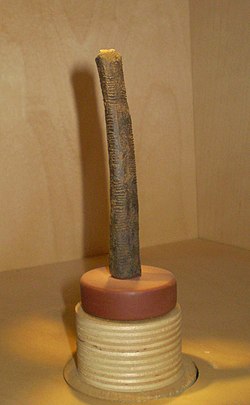õ╝ŖÕ░ܵłłķ¬©Õ▒ĢÕć║õ║ĵ»öÕł®µŚČńÜćÕ«ČĶć¬ńäČń¦æÕŁ”ńĀöń®ČµēĆ õ╝ŖÕ░ܵłłķ¬© µś»õĖĆõĖ¬ķ¬©ÕÖ© ’╝īÕÅ»Ķ┐Įµ║»Ķć│µŚ¦ń¤│ÕÖ©µŚČõ╗ŻµŚ®µ£¤ ŃĆéÕ«āµś»õĖƵØĪµÜŚĶżÉĶē▓ńÜäńŗÆńŗÆńÜäĶģōķ¬©’╝ī[ 1] ń¤│Ķŗ▒ ’╝īõ╣¤Ķ«ĖõĖ║õ║åńö©õ║ÄķøĢÕł╗ŃĆéõĖĆÕ╝ĆÕ¦ŗÕ«āĶó½Ķ«żõĖ║µś»õĖƵĀ╣Ķ«░µĢ░µŻŹ’╝īÕøĀõĖ║õĖŖķØóńÜäõĖēÕłŚÕł╗ńŚĢĶó½Ķ¦ŻķćŖõĖ║Ķ«ĪµĢ░ń¼”ÕÅĘ’╝īõĮåµś»õ╣¤µ£ēõ║║Ķ«żõĖ║Ķ┐Öõ║øÕł╗ńŚĢÕŬµś»õĖ║õ║åµ¢╣õŠ┐µŖōµÅĪ’╝īµł¢ĶĆģÕģČõ╗¢ńÜäķØ×µĢ░ÕŁ”ńÜäńÉåńö▒ŃĆé[ 2]
õ╝ŖÕ░ܵłłķ¬©õ║Ä1960Õ╣┤ńö▒µ»öÕł®µŚČõ║║Jean de Heinzelin de BraucourtÕÅæńÄ░’╝īÕĮōµŚČõ╗¢µŁŻÕ£©µÄóń┤óµ»öÕ▒×ÕłÜµ×£ Õī║Õ¤¤ŃĆé[ 3] [ 4] ńł▒ÕŠĘÕŹÄµ╣¢ µ▒ćÕģźÕĪ×Õ¦åÕł®µ▓│’╝īÕĮóµłÉõ║åÕ░╝ńĮŚµ▓│µĄüÕ¤¤ ńÜäķā©Õłåµ║ÉÕż┤’╝łõ╗Ŗõ╣īÕ╣▓ĶŠŠ ÕÆīÕłÜµ×£µ░æõĖ╗Õģ▒ÕÆīÕøĮ ńÜäĶŠ╣ÕóāõĖŖ’╝ēŃĆéķ¬©Õż┤ÕÅæńÄ░ńÜäÕ£░µ¢╣µś»ķØ×µ┤▓Ķ┐ÖõĖ¬Õī║Õ¤¤õĖĆõĖ¬Õ░ÅÕ×ŗńÜäµĖöńīÄķććķøåńżŠÕī║ńÜäķüŚĶ┐╣ŃĆéĶ┐ÖõĖ¬Õ«ÜÕ▒ģńé╣ńäܵ»üõ║ÄõĖƵ¼Īńü½Õ▒▒ńłåÕÅæ ŃĆé[ 5] [ 6]
Ķ┐ÖõĖ¬õ║║ķĆĀńē®µ£ĆÕłØĶó½õ╝░Ķ«ĪĶĄĘµ║Éõ║ÄÕģ¼ÕģāÕēŹ9000Õ╣┤Õł░Õģ¼ÕģāÕēŹ6500ÕżÜÕ╣┤ŃĆé[ 7] [ 8] [ 9]
õ╝ŖÕ░ܵłłķ¬©µ░Ėõ╣ģµĆ¦Õ▒ĢĶ¦łõ║ĵ»öÕł®µŚČ ÕĖāķ▓üÕĪ×Õ░ö µ»öÕł®µŚČńÜćÕ«ČĶć¬ńäČń¦æÕŁ”ńĀöń®ČµēĆ ÕżäŃĆé[ 10] [ 11] [ 12]
ń¼¼õĖĆ’╝łµ£ēµŚČÕĆÖÕŽÕüÜõĖŁķŚ┤’╝ēÕłŚ’╝īÕøŠńēćõĖŁõĖŹÕÅ»Ķ¦ü’╝īõ╗ÄõĖŗÕł░õĖŖ ń¼¼õ║ī’╝łµł¢ÕÅ│’╝ēÕłŚ’╝łÕøŠńēćÕĘ”ĶŠ╣’╝ēŃĆüõ╗ÄõĖŗÕł░õĖŖ ń¼¼õĖē’╝łµł¢ÕĘ”’╝ēÕłŚ’╝łÕøŠńēćńÜäÕÅ│ĶŠ╣’╝ēŃĆüõ╗ÄõĖŗÕł░õĖŖ ķ¬©Õż┤õĖŖńÜäÕł╗ńŚĢÕłåµłÉõĖŹÕ»╣ń¦░ńÜäõĖēÕłŚ’╝īĶ┐ÖÕ»╝Ķć┤õ║åŌĆ£ÕÉäń¦ŹĶ»▒õ║║ńÜäÕüćĶ«ŠŌĆØ,[ 13] µĢ░ÕŁŚń│╗ń╗¤ ŃĆé
ń¼¼õĖēÕłŚĶó½Ķ¦ŻķćŖõĖ║ŌĆ£Ķ┤©µĢ░ĶĪ©ŌĆØ’╝ī[ 14] [ 15]
õ║ÜÕÄåÕ▒▒Õż¦ŌƦķ®¼µ▓ÖÕģŗÕłÖµÄ©µĄŗ’╝īõ╝ŖÕ░ܵłłķ¬©õ╗ŻĶĪ©õĖĆõĖ¬ÕģŁõĖ¬µ£łõĖ║Õ橵£¤ńÜäÕż¬ķś┤ÕÄå’╝łÕ¤║õ║ĵ£łńøĖńÜäÕÄåµ│Ģ’╝ēŃĆéÕģŗÕŖ│Ķ┐¬Õ©ģŌƦµēĵ¢»µŗēÕż½µ¢»Õć»Õ░▒µŁżĶ«żõĖ║’╝īĶ┐ÖõĖ¬ÕĘźÕģĘÕłøķĆĀĶĆģÕÅ»ĶāĮµś»õĖĆõĖ¬Õź│õ║║’╝īńö©µØźĶʤĶĖ¬µ£łńøĖ Õ橵£¤ńøĖÕģ│ńÜäµ£łń╗ÅÕ橵£¤ ŃĆé[ 16] [ 17] [ 18]
1959Õ╣┤Õ»╣õ╝ŖÕ░ܵłłÕ£░Õī║ńÜ䵌®µ£¤µī¢µÄśõĖŁ’╝īĶ┐śÕÅæńÄ░õ║åÕÅ”Õż¢õĖĆÕØŚķ¬©Õż┤ŃĆéķó£Ķē▓µø┤µĘĪ’╝īĶó½Õł«ÕēŖŃĆüµēōĶ¢äÕ╣ȵēōńŻ©Ķ┐ć’╝īõĖĆń½»ÕĘ▓ń╗ÅńĀ┤µŹ¤’╝īµÜ┤ķ£▓Õć║ń®║ĶģöŃĆéĶ┐ÖõĖ¬ÕÅżńē®ÕÅ»ĶāĮÕÆīĶæŚÕÉŹńÜäķéŻÕØŚķ¬©Õż┤õĖƵĀĘ’╝īõĖĆń½»ÕĄīµ£ēń¤│Ķŗ▒’╝īõĮ£õĖ║õĖĆõĖ¬ÕĘźÕģĘńÜäµŖŖµēŗõĮ┐ńö©ŃĆé14ÕÄśń▒│ńÜäķĢ┐ķ¬©ńÜäÕģŁõĖ¬õŠ¦ķØó’╝īÕł╗µ£ē90õĖ¬Õł╗ńŚĢ’╝īµĀ╣µŹ«ķĢ┐Õ║”Ķó½ÕĮÆń▒╗õĖ║ŌĆ£õĖ╗Ķ”üŌĆصł¢ŌĆ£ĶĮ╗ÕŠ«ŌĆØŃĆéJean de HeinzelinńÜäĶ¦ŻķćŖĶ«żõĖ║õĖ╗Ķ”üÕł╗ńŚĢõĖ║ÕŹĢõĮŹµł¢ÕĆŹµĢ░’╝īĶĆīĶĮ╗ÕŠ«ńÜ䵜»ÕłåµĢ░µł¢ĶĆģõĮÖµĢ░ŃĆéõ╗¢Ķ«żõĖ║Ķ┐ÖÕØŚķ¬©Õż┤µś»ńö©µØźĶ«░ÕĮĢ10Ķ┐øÕłČÕÆī12Ķ┐øÕłČµŹóń«ŚĶ¦äÕłÖńÜäŃĆé[ 19]
^ A very brief history of pure mathematics: The Ishango Bone . [2018-07-26 ] . ’╝łÕĤզŗÕåģÕ«╣ÕŁśµĪŻ õ║Ä2008-07-21’╝ē. ^ Rudman, Peter Strom. How Mathematics Happened: The First 50,000 Years . Prometheus Books. 2007: 63 . ISBN 978-1-59102-477-4 ^ de Heinzelin, Jean: "Ishango", Scientific American
^ Lake Edward . [12 October 2014] . ’╝łÕĤզŗÕåģÕ«╣ ÕŁśµĪŻõ║Ä2016-06-23’╝ē. ^ Williams, Scott W.: "Mathematicians of the African Diaspora ’╝łķĪĄķØóÕŁśµĪŻÕżćõ╗Į ’╝īÕŁśõ║Äõ║ÆĶüöńĮæµĪŻµĪłķ”å ’╝ē" The Mathematics Department of The State University of New York at Buffalo .
^ D. Huylebrouck, The Bone that Began the Space Odyssey [µ░Ėõ╣ģÕż▒µĢłķĆŻńĄÉ
^ Gerdes, Paulus (1991): On The History of Mathematics in Africa South of the Sahara ’╝łķĪĄķØóÕŁśµĪŻÕżćõ╗Į ’╝īÕŁśõ║Äõ║ÆĶüöńĮæµĪŻµĪłķ”å ’╝ē; African Mathematical Union, Commission on the History of Mathematics in Africa.
^ Marshack, Alexander (1991): The Roots of Civilization , Colonial Hill, Mount Kisco, NY.
^ Brooks, A.S. and Smith, C.C. (1987): "Ishango revisited: new age determinations and cultural interpretations", The African Archaeological Review , 5 : 65-78.
^ Introduction ’╝łķĪĄķØóÕŁśµĪŻÕżćõ╗Į ’╝īÕŁśõ║Äõ║ÆĶüöńĮæµĪŻµĪłķ”å ’╝ē, Royal Belgian Institute of Natural Sciences, Brussels, Belgium.^ Flash presentation ’╝łķĪĄķØóÕŁśµĪŻÕżćõ╗Į ’╝īÕŁśõ║Äõ║ÆĶüöńĮæµĪŻµĪłķ”å ’╝ē, Royal Belgian Institute of Natural Sciences, Brussels, Belgium.^ The Ishango Bone, Democratic Republic of the Congo ’╝łķĪĄķØóÕŁśµĪŻÕżćõ╗Į ’╝īÕŁśõ║Äõ║ÆĶüöńĮæµĪŻµĪłķ”å ’╝ē, on permanent display at the Royal Belgian Institute of Natural Sciences, Brussels, Belgium.^ Everett, Caleb. Numbers and the Making of Us: Counting and the Course of Human Cultures . Harvard University Press. 2017: 35. ISBN 9780674504431 ^ Williams, Scott W.: "Mathematicians of the African Diaspora" The Mathematics Department of The State University of New York at Buffalo.[1] ’╝łķĪĄķØóÕŁśµĪŻÕżćõ╗Į ’╝īÕŁśõ║Äõ║ÆĶüöńĮæµĪŻµĪłķ”å ’╝ē
^ Rudman, Peter Strom. How Mathematics Happened: The First 50,000 Years . Prometheus Books. 2007: 64 . ISBN 978-1-59102-477-4 ^ Zaslavsky, Claudia: Africa Counts: Number and Pattern in African Culture , L. Hill, 1979.
^ Zaslavsky, Claudia: "Women as the First Mathematicians ’╝łķĪĄķØóÕŁśµĪŻÕżćõ╗Į ’╝īÕŁśõ║Äõ║ÆĶüöńĮæµĪŻµĪłķ”å ’╝ē", International Study Group on Ethnomathematics Newsletter , Volume 7 Number 1, 1992|January 1992.
^ Robinson, Judy. 1992.
^ The Second Bone . [12 October 2014] . ’╝łÕĤզŗÕåģÕ«╣ ÕŁśµĪŻõ║Ä2016-06-23’╝ē.
Shurkin, J.: Engines of the mind: a history of the computer , W. W. Norton & Co., 1984., p21
Bogoshi, J., Naidoo, K. and Webb, J.: "The oldest mathematical artifact", Math. Gazette , 71:458 (1987) 294.

















